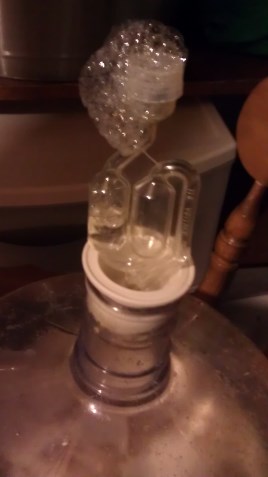Yesterday, before most people were awake in the neighborhood, these Brew Dudes were up to some homebrewing activities.
The main attraction was a braggot brew session. I did a small mash (5 pounds of grain) and 1 addition of hops for the full sixty minute boil so the kettle didn’t need constant attention. We checked on it just to make sure it was still rolling with the boil.
While that was going, we bottled and corked the cyser that had been conditioning since December in my basement. Even though we discovered that my auto-siphon had a big crack in it, the transfer from carboy to bottling bucket went okay.

This cyser was the first brew I have ever corked. The newfangled corking device that Mike bought for his foray into wine this past fall is really easy to use. With slightly less than a gallon to package, I was able to cap three 12 ounce bottles for competition and cork three wine bottles for consumption at a later date.
Then, we bottled the Scottish 70 shilling ale. I drew a sample off of the carboy just to get an idea of the flavor profile. That yeast strain does some funny things. There was a definite peat-y note to it. I can’t wait for it to condition in the bottle for a few weeks to see how it is when it matured a bit.
With the Scottish Ale bottled and the wort chilling, 6 pounds of honey was poured into the just emptied carboy – right on top of the yeast cake.
This raw honey was slow moving. It took a while for it to run through the funnel. Once I got the wort cooled to fermentation temperatures, pouring the wort on top of the honey helped to move things along.
I did add a little yeast nutrient and energizer to the carboy before I sealed it. Within two hours, the airlock was bubbling pretty intensely. Hooo boy.
Brew On!

SeñorBrew™
John,
You’re such a braggart, braggot, however the heck you spell it.
John
No – I am quite modest actually.
Daniel
Hi and thanks for a great blog. With my microbiology background I noticed something, adding the honey (or any other concentrated solution) right on top of the yeast cake will create a huge osmotic pressure and probably kill off part of the yeast population. Im sure that with the billions of cells in the yeast cake made up for the loss of a few thousand/million. But anyway, if you want maximum viability you should probably add the honey after the wort.
Just my 2 cents!
Mike
Hey Daniel thanks for the support and the comment. I am a biologist professionally to and I agree with your assessment of the osmotic pressure issues. Like anything in biology there is a time factor too. I wonder what the true lysis half life of the the yeast cake is with the honey on top of it. Second, we added said honey and within a few minutes we were adding the wort on top. We stopped the wort addition about a third of the way through to mix and shake up the fermentor and get the honey incorporated, so that limited the osmolarity/time quotient a bit too. Maybe another option would be to have added the 1/3 of wort then the honey, then finish with the wort.
Please comment frequently with your microbiology expertise in the future. The more view points the better.